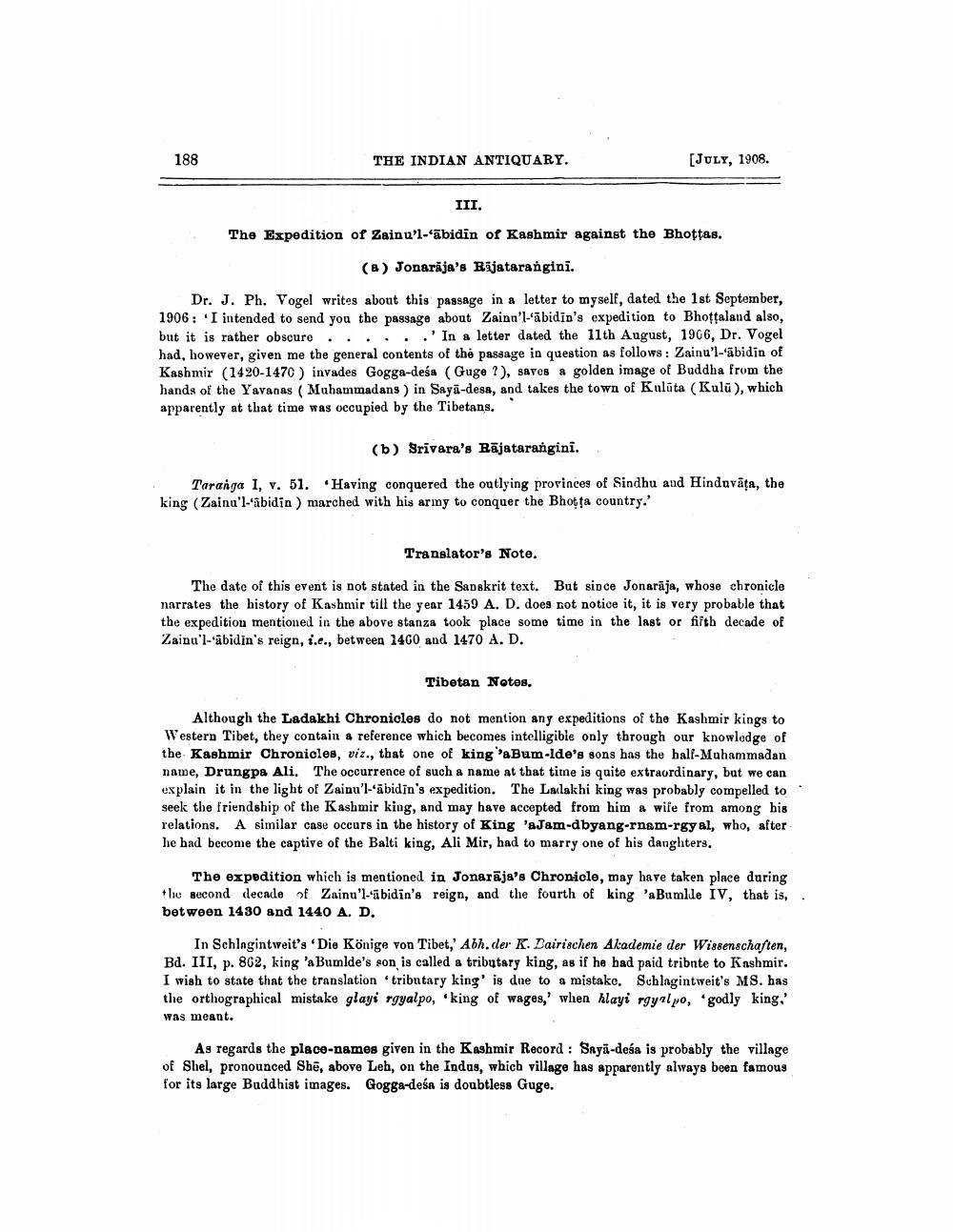________________
188
THE INDIAN ANTIQUARY.
[JULY, 1908.
III. The Expedition of Zainu'l-abidin of Kashmir against the Bhottas.
(8) Jonarāja's Bājatarangini.
Dr. J. Ph. Vogel writes about this passage in a letter to myself, dated the 1st September, 1906: 'I intended to send you the passage about Zainn'l-'ābidin's expedition to Bhogaland also, but it is rather obscure ......' In a letter dated the 11th August, 1966, Dr. Vogel had, however, given me the general contents of the passage in question as follows: Zainu'l-'abidin of Kashmir (1420-1470) invades Gogga-deśa (Guge ?), saves a golden image of Buddha from the hands of the Yavanas ( Muhammadans ) in Sayā-desa, and takes the town of Kulūta (Kulü), which apparently at that time was occupied by the Tibetans.
(b) Srivara's Rājatarangini.
Taranga 1, v. 51. Having conquered the outlying provinces of Sindhu and Hinduvāța, the king (Zainu'l-'abidin ) marched with his army to conquer the Bhoffa country.'
Translator's Note.
The date of this event is not stated in the Sanskrit text. But since Jonarāja, whose chronicle narrates the history of Kashmir till the year 1459 A. D. does not notice it, it is very probable that the expedition mentioned in the above stanza took place some time in the last or fifth decade of Zainu'l-abidin's reign, i.e., between 1460 and 1470 A. D.
Tibetan Notes.
Although the Ladakhi Chronicles do not mention any expeditions of the Kashmir kings to Western Tibet, they contain a reference which becomes intelligible only through our knowledge of the Kashmir Chronicles, viz., that one of king'aBum-lde's sons has the half-Muhammadan name, Drungpa Ali. The occurrence of such a name at that time is quite extraordinary, but we can explain it in the light of Zainu'l-abidin's expedition. The Lalakhi king was probably compelled to seek the friendship of the Kashmir king, and may have accepted from him a wife from among his relations. A similar case occurs in the history of King 'aJam-dbyang-rnam-rgyal, who, after he had become the captive of the Balti king, Ali Mir, had to marry one of his danghters,
The expedition which is mentioned in Jonarāja's Chronicle, may have taken place during + lo second decade of Zainu'l-'abidin's reign, and the fourth of king 'a Bumlie IV, that is, between 1430 and 1440 A. D.
In Schlngintweit's Die Könige von Tibet, Abh.der K. Dairischen Akademie der Wissenschaften, Bd. III, p. 862, king 'a Bumlde's son is called a tributary king, as if he had paid tribnte to Kashmir. I wish to state that the translation tributary king' is due to a mistake. Schlagintweit's MS. has the orthographical mistake glays rgyalpo, 'king of wages, when hlayi rgyalpo, 'godly king,' was meant.
As regards the place-names given in the Kashmir Record : Saya-desa is probably the village of Shel, pronounced Shē, above Leb, on the Indas, which village has apparently always been famous for its large Buddhist images. Gogga-deśa is doubtless Guge.




